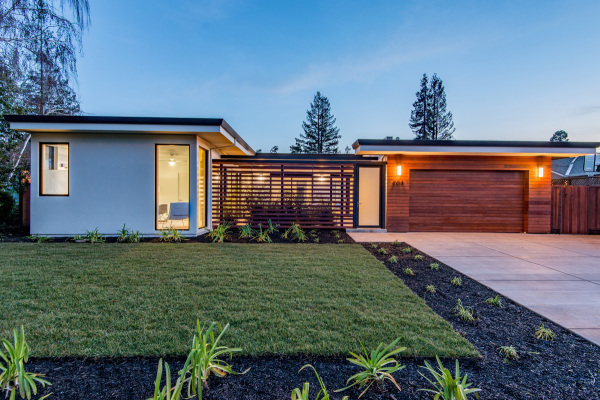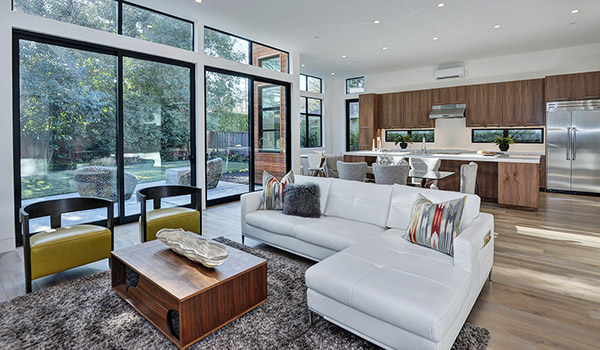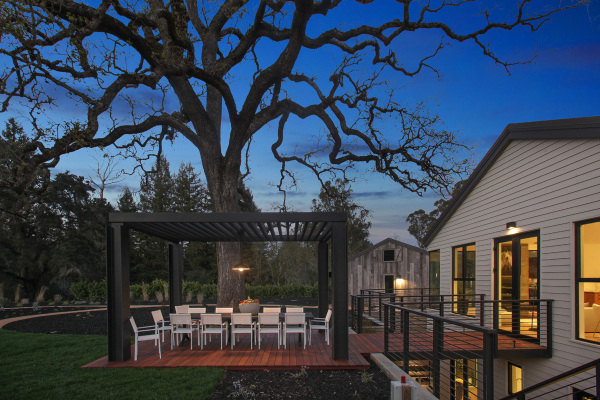These resources are from an archived version of our website. Want to see what we’ve been up to lately? Check out our new website.
Form or Function? Have both when you build a modern home
Arts & Crafts visionary William Morris said, “Have nothing in your house that you do not know to be useful or believe to be beautiful.” Later, the founding father of “organic architecture” and a big fan of Morris, Frank Lloyd Wright, expanded on this idea, popularizing the now-familiar mantra “Form follows function.”
To this day, modern home designs reflect Lloyd Wright’s hallmark of ordered elegance. Why is modern home design so well suited to deliver high-performance efficiencies and superior design?

Modern homes evoke timeless design complemented by cutting-edge technologies.
Modern homes are devoid of trends, gimmicks or unnecessary ornamentation. Simplicity of design elevates quality over quantity. When design serves a purpose, in addition to being aesthetically beautiful, it stands the test of time.
In modern homebuilding, this purpose-driven design begins with considering the homeowner’s lifestyle and is rooted in a whole-house systems philosophy. From air and heating systems that work with the seasons, to how inhabitants transition from one room to another, nothing is left to chance. The home becomes a holistic ecosystem designed for ease and comfort.
From a functional perspective, efficiency is explored through the use of high-performance construction innovations. Building techniques and materials designed to minimize resource consumption and lighten environmental impact are prioritized. Advanced structural panels (SIPS) on walls and roofs provide superior ongoing energy savings and are a more environmentally sustainable building material than traditional framing. The functional result is a better performing home which is quieter and more durable than conventional construction. From an aesthetic standpoint, these materials create the foundation for elegant simplicity, lending themselves naturally to clean lines and modern shapes.
Superior functionality is a beautiful thing to live with and to look at.
Unlike traditional architecture, modern homes tend to eliminate or reduce hallways and transitional spaces for an open flow between rooms. This structural simplicity is not only easier to navigate, but it is also more visually appealing and lifestyle-intuitive. Gestalt Psychology tells us that humans love balanced, symmetrical designs. When our brains have less visual information to process, we feel more relaxed and positive. Add an energy-efficient heating and cooling system like the Zehnder Heat Recovery Ventilator (HRV) to this continuous space and fresh air flows freely to all corners of the home. An HRV supplies constant fresh air –reducing humidity, mold, and mildew. This exceptional indoor air quality is also up to 90% less expensive than traditional heating systems.
Nowhere else better showcases the value of modern design than kitchens and bathrooms. Less ornamentation, uninterrupted surfaces, and linear shapes achieve a spa-like serenity in the modern bath. A modern kitchen is designed to maintain a look of orderliness and spaciousness. Clean lines and a minimalist approach mean these spaces are easier to clean and easier to navigate. Ample storage and appliances are arranged to be of the most utility. These spaces are more intuitive to our contemporary lifestyles.

Harnessing natural light is better for your health, your wallet, and the planet.
One of the most eye-catching features of modern home design is expansive windows resulting in light-filled interiors. The health benefits of natural light should not be underestimated. Scientists at the Lighting Research Center, for example, have reported that naturally-lit environments improve inhabitant health, and increase productivity and comfort.
Modern plans make use of strategically-placed, high-performance windows without sacrificing privacy or energy efficiency. Additionally, modern homes often include exceptional views of the natural surroundings as a compliment to interior decor.
All this light has a functional benefit, too. Passive solar homes, in particular, are carefully oriented to make use of natural light. Advanced photovoltaic systems harness the sun to fully power a home’s heating, hot water, and electricity. Through a building design process called daylighting, home orientation, windows, and interior spaces are arranged to maximize the daily movement of light in support of human health and activities and to reduce energy demand.

At one with nature, indoors and out.
Modern home design goes beyond just providing views of the outdoors – it invites the natural environment inside. Through transitional atriums and patios, the surrounding landscape is integrated with extended rooflines and covered awnings. Interior finishes are often styled with natural materials such as wood, stone, and metal. Intrinsically beautiful, the authentic nature of these materials infuses a home with earthy textures and colors, creating a calm and neutral aura. Luxurious, and sustainable, natural materials with limited processing are chosen to minimize environmental impact – and be free of environmental toxins.
Achieve beautiful form and unprecedented function with Clarum Homes
Pairing form and function creates envy-worthy homes, supported by the most advanced building technologies. Clarum’s modern homes are built with your core functionality in mind, without sacrificing beauty and long-term sustainability and durability. By being in harmony with nature and purposeful in design, a modern home is both elegant and comfortable – as well as healthier and more efficient.
Want to learn more about how Clarum can help you build the modern home of your dreams? Give us a call at 650.322.7069.








